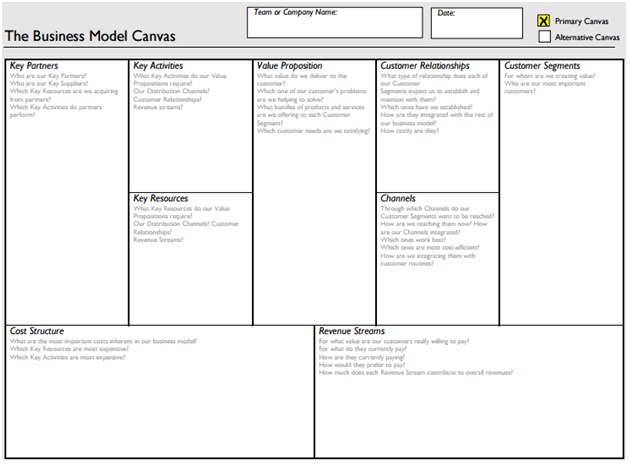When it comes to entrepreneurship, every startup needs a set of solid plans to execute and succeed. Don’t get me wrong, I’m not talking about your marketing plan, product development plan or even your FY-Business plan. You got to go one step further and dig deeper to lay out a solid foundation that all of the above plans sit on it. This is called your business model, where you define almost everything from your customer segment to key activities and revenue streams.

All you need to do is to follow me on this article as I’ll walk you through the 4 essential steps to help you craft your startup business plan.
It all depends on your business model!
All entrepreneurs I met during my startup coaching programs dream of launching a startup that’s difficult to compete with, who doesn’t?
When you ask for advice on how to boost my business, it’s very probable that you hear these two types of advises: “Marketing is important, budget for it”; or” you should spend money on Google ads”. I’ve heard it too, but I’m afraid, your success isn’t about any of them.
If you have no idea what you are doing, then they are definitely good points to follow but if you aim to succeed in your business you ought to accept the fact that your startup should have a solid business model.
Obviously, your business model is not everything but is the first place to start. You get this right; I bet you will get there quickly.
Here is the trick
Regardless of what stage your startup’s in, you must always pay attention to 9 building blocks. The 9 building blocks of business model canvas help you monitor progress of your progress in 1 page. Isn’t that amazing?
Simply follow the steps I mentioned below and start developing your business model.
After completion of your business model, you can move on and work on your business strategy, A.K.A “business model patterns” using the definitive guide for startup business models,
First Rule: What you have read and heard about business plan is not working anymore!
What do I mean?
If you look around and ask business professional what is a business plan you’d probably hear about a lengthy document with many pages about 3 to 5 years’ financial forecast, operational procedures, etc.
Well, that was way before business model canvas transformed the way startups work. You need a tool and an approach to help you craft everything in a matter of minutes, at max hours, and then turn your focus on important things in your business.
Remember, spending lot of time on writing a traditional business plan won’t help you because that’s purely based on hypothesis, not proven facts!
With Business model canvas, you can write your business model in a matter of hours and Most importantly ‘TEST IT’ with your customers to validate your idea.
Alright, let’s jump right in and learn how to work on your startup business plan.
Your approach towards business model matters!
Unless you are alone in your startup, which is a rare case these days, you have a team of talented people, then why not get them involve and see what they see?
Being open to other ideas and embracing collaboration is the key in working on your business model.
Your objective is to hear everyone out, and at the same time convey your idea and get everyone on the same page.
To begin with, download the business model canvas template. Print a few copy of it on a big size paper and place it on the wall and follow these exact 7 steps:

- Define your stake holders, those who are impacted and involved in your decisions. Invite all of them for a collaborative brainstorming session. Don’t limit yourself, you can get everybody else in there too
- Kick of the session by explaining your idea, your vision, and how you think the business should move forward.
- Don’t Force your idea, just share it. Don’t forget to allow others to object
- Let everyone know that by the end of the session you are all leaving out with the 1st version of your business model.
- No technical-jargon discussion is allowed.
- Do not write on the business model canvas, EVER! Instead, simply use sticky notes and ask the team to write their ideas, whenever they have a point about each building block and place them on the wall.
- Once you are done with all building blocks, get out of the building and ask for feedback from customers. Don’t forget that your current version of business model canvas is not your finalized version and requires iteration.
4 Steps to write a productive Startup Business Plan
Having the above mentioned tips in mind, it’s time to move to 9 building blocks of business model canvas and prepare your 1st draft.
Step 1: What are you selling and to whom?
Your Value Proposition should be easy to understand. It’s all about what pain are you addressing for your customers and what do they gain if they buy from you.
When you think about your customer segment, your main question should be about who are my customers and why should they buy from us?
Begin defining your customer segment by asking open ended questions and find out:
- Who do you think is willing to pay for your service or product?
- What type of characters do you believe will spend money and buy your offering?
- What market research facts do you have to back up your assumption?
Step 2: What channels do you use to reach out to your customers?
You need to connect your Value proposition and your customer segment together and that can be done through “Channels”.
To be successful in customer discovery process, you ought to strengthen your relationship with both suppliers and customers.
Think of channels as ways to build long lasting business relationship that can boost your business and increase revenue.
In your discussion with your team to fill in your business model canvas, you should ask your team to suggest the main channels that differentiate your startup from others.
Step 3: What activities & resources add value to your startup
Focusing on the hiring the right resource, investing in the right asset, executing the best activity and crafting the right strategy helps you differentiate your startup from others.
For example, your branding and marketing strategy should be about activities that increase your startup reputation and ultimately convert visitors to customers and more revenue.
Brainstorm and answer the following questions:
- Who should we hire?
- What skill sets are most valuable to our startup?
- What collaborative activities or partnership opportunities should we involve in?
Step 4: How to make money and manage costs?
Another block in your business model that needs lots of attention is your revenue stream and your cost structure.
This is where you clarify how your startup makes money and what costs do you incur to operate the business.
Your revenue stream should be simplified, so the less revenue stream you have the better.
In your brainstorming session, ask your team about the following questions:
- What are that main categories you’d have to spend money to keep the business running? Is it Talent? Infra structure? Branding? etc.
- How do you expect your customers to pay?
- Do you plan use pay per use model? Premium, units sold? Etc.
It’s your turn now, Comment below and let me know how does your startup business plan look like?














